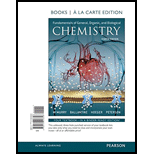
Concept explainers
(a)
Interpretation:
Following amino acids are on the surface of a globular protein or fibrous protein has to be identified.
Concept introduction:
- Fibrous protein is a tough, insoluble protein whose protein chains form fibers or sheets.
- Globular protein is a water soluble protein whose chain is folded in a compact shape with hydrophilic groups on outside.
(b)
Interpretation:
Following amino acids are on the surface of a globular or fibrous protein has to be identified.
Concept introduction:
- Fibrous protein is a tough, insoluble protein whose protein chains form fibers or sheets.
- Globular protein is a water soluble protein whose chain is folded in a compact shape with hydrophilic groups on outside.
(c)
Interpretation:
Following amino acids are on the surface of a globular or fibrous protein has to be identified.
Concept introduction:
- Fibrous protein is a tough, insoluble protein whose protein chains form fibers or sheets.
- Globular protein is a water soluble protein whose chain is folded in a compact shape with hydrophilic groups on outside.
(d)
Interpretation:
Following amino acids are on the surface of a globular or fibrous protein has to be identified.
Concept introduction:
- Fibrous protein is a tough, insoluble protein whose protein chains form fibers or sheets.
- Globular protein is a water soluble protein whose chain is folded in a compact shape with hydrophilic groups on outside.
(e)
Interpretation:
Following amino acids are on the surface of a globular or fibrous protein has to be identified.
Concept introduction:
- Fibrous protein is a tough, insoluble protein whose protein chains form fibers or sheets.
- Globular protein is a water soluble protein whose chain is folded in a compact shape with hydrophilic groups on outside.
(f)
Interpretation:
Following amino acids are on the surface of a globular or fibrous protein has to be identified.
Concept introduction:
- Fibrous protein is a tough, insoluble protein whose protein chains form fibers or sheets.
- Globular protein is a water soluble protein whose chain is folded in a compact shape with hydrophilic groups on outside.
Want to see the full answer?
Check out a sample textbook solution
Chapter 18 Solutions
Fundamentals of General, Organic, and Biological Chemistry, Books a la Carte Edition (8th Edition)
- Globular proteins are typically constructed from several layers of secondary structure, with a hydrophobic core and a hydrophilic surface. Is this true for a fibrous protein such as keratin?arrow_forwardWhat structural relationship is indicated by term D glucose.?arrow_forwardAre all the amino-acids soluble in water? Explain why?arrow_forward
- Generally speaking, what two considerations determine whether a specific dihedral angle will be permitted to exist in a protein?arrow_forwardIn what type of intra and intermolecular interactions does a valine within a protein backbone typically participate?arrow_forwardWhat is the diference between soluble and insoluble iber?arrow_forward
- What is the quarternary structure of the protein leptin?arrow_forwardwhat are the four interactions that keep the protein structure intact?arrow_forwardWhy is the ionic bond between, say, the side chain of lysine and the side chain of glutamic acid stronger in the hydrophobic interior of a protein than in aqueous solvent (water)?arrow_forward
- What are the general characteristics of the primary, secondary, tertiary, and quaternary structure of proteins?arrow_forwardAn amino acids unique property arises through which component? How does this same component contribute to the overall chemical nature of the protein?arrow_forwardAre peptide bonds free to rotate in folded protein? Can they be ionized at extreme pH values?arrow_forward
 BiochemistryBiochemistryISBN:9781319114671Author:Lubert Stryer, Jeremy M. Berg, John L. Tymoczko, Gregory J. Gatto Jr.Publisher:W. H. Freeman
BiochemistryBiochemistryISBN:9781319114671Author:Lubert Stryer, Jeremy M. Berg, John L. Tymoczko, Gregory J. Gatto Jr.Publisher:W. H. Freeman Lehninger Principles of BiochemistryBiochemistryISBN:9781464126116Author:David L. Nelson, Michael M. CoxPublisher:W. H. Freeman
Lehninger Principles of BiochemistryBiochemistryISBN:9781464126116Author:David L. Nelson, Michael M. CoxPublisher:W. H. Freeman Fundamentals of Biochemistry: Life at the Molecul...BiochemistryISBN:9781118918401Author:Donald Voet, Judith G. Voet, Charlotte W. PrattPublisher:WILEY
Fundamentals of Biochemistry: Life at the Molecul...BiochemistryISBN:9781118918401Author:Donald Voet, Judith G. Voet, Charlotte W. PrattPublisher:WILEY BiochemistryBiochemistryISBN:9781305961135Author:Mary K. Campbell, Shawn O. Farrell, Owen M. McDougalPublisher:Cengage Learning
BiochemistryBiochemistryISBN:9781305961135Author:Mary K. Campbell, Shawn O. Farrell, Owen M. McDougalPublisher:Cengage Learning BiochemistryBiochemistryISBN:9781305577206Author:Reginald H. Garrett, Charles M. GrishamPublisher:Cengage Learning
BiochemistryBiochemistryISBN:9781305577206Author:Reginald H. Garrett, Charles M. GrishamPublisher:Cengage Learning Fundamentals of General, Organic, and Biological ...BiochemistryISBN:9780134015187Author:John E. McMurry, David S. Ballantine, Carl A. Hoeger, Virginia E. PetersonPublisher:PEARSON
Fundamentals of General, Organic, and Biological ...BiochemistryISBN:9780134015187Author:John E. McMurry, David S. Ballantine, Carl A. Hoeger, Virginia E. PetersonPublisher:PEARSON





